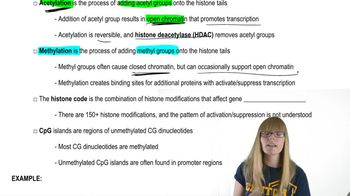Here are the essential concepts you must grasp in order to answer the question correctly.
Nucleosomes
Nucleosomes are the fundamental units of chromatin, consisting of a segment of DNA wrapped around a core of histone proteins. This structure helps package DNA into a compact form, allowing it to fit within the cell nucleus. The arrangement and modification of nucleosomes play a crucial role in regulating access to DNA, thereby influencing gene expression.
Recommended video:
Histone Modifications
Histone modifications, such as acetylation and methylation, are chemical changes to the histone proteins that can alter chromatin structure and function. Acetylation typically leads to a more open chromatin configuration, promoting gene activation, while methylation can either activate or repress gene expression depending on the specific context. These modifications serve as signals that can recruit other proteins to regulate transcription.
Recommended video:
Histone Protein Modifications
Chromatin Structure and Gene Activity
The structure of chromatin, which can exist in a more condensed (heterochromatin) or relaxed (euchromatin) state, directly impacts gene activity. Changes in chromatin structure, influenced by histone modifications, can either facilitate or hinder the binding of transcription factors and RNA polymerase to DNA, thus regulating the transcription of genes. Understanding these dynamics is essential for elucidating how genes are turned on or off in response to various cellular signals.
Recommended video:





